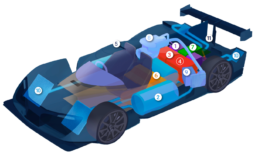OPERATING SCHEME OF OUR ELECTRIC-HYDROGEN PROTOTYPES

1- The electric engines:
Four electric engines mounted on the rear wheels (two on each) provide propulsion.
2- The three hydrogen tanks:
The dihydrogen (H2) is stored in three pressurized (700 bars) carbon filament tanks used to fuel the cell. The first two are placed on either side of the cockpit and the third just behind the driver.
3- The hydrogen fuel cell:
It comprises four stacks at the core of which molecules of dihydrogen (H2 stored in the tanks) and oxygen atoms combine to form water molecules (H20). This reaction produces heat, and electricity, which drives the car’s electric motors.
4- The stack:
A layered pile of 230 cells, bipolar plates and hydrogen porous membranes.
.
5- The air intake:
The ambient air used to produce the reaction within the stacks enters through this vent. First of all, it is filtered, propelled to the compressor and then to the humidifier before entering the stacks.
6- The buffer-batteries:
Excess electricity produced by the hydrogen fuel-cell and the KERS system in the braking phase feeds into these high-performance cells. This allows the driver to double the car’s acceleration potential (from 250 kw to 480 kw, the equivalent of around 653 bhp).
7- The transmission:
A special one-gear box manages rear wheels independently and is designed to reduce grinding.
8- The compressor:
It compresses and accelerates the air that enters via the vent (up to 300g of air per second) and operates at 100000 revolutions per minute. The modulation of the air flow injected into the stacks varies the reaction and therefore determines the amount of electric power produced.
9- The humidifier:
Humidified air improves the reaction between the oxygen atoms and dihydrogen molecules. The humidifier guarantees that the level of humidity of the air injected into the stacks remains constant.
10- Radiators and cooling system:
11- The exhaust:
The only emission produced by the GreenGT LMPH2G is water (H2O). Steam escapes through four vents (one per stack) in the middle of the aerodynamic diffuser at the rear of the car.


